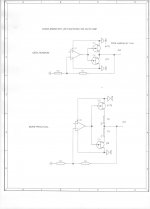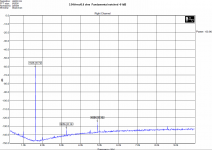except the buffer isn't doing anything per the recent discussion - not buffering the input op amp from feedback and RIAA loads
But that would mean GNFB.
Ok But we know that. David just said he tried the suggested IC circuit as his first circuit he tried.--- didnt cut muster for him. Need better..... David cant stand the idea that a buffer amp on the output of his high super clean osc will reduce the performance of his hard work.
We need the best design ever that money can buy/build.
THx-RNMarsh
But did he try everything? IC op-amps that by necessity have the compensation capacitance referenced to one of the rails benefit from things like I proposed on the AD8010 datasheet. For its day this was a rather substantial load for an 8-pin DIP. 8 parallel 150 Ohm video loads at SOTA diff gain and phase (i.e. inherent linearity).
Last edited:
What do you gents think of this?
This design was published in 1990 or '91 in a German magazine. It was designed by Dr Herman Holger, working for Burr-Brown in Germany.
Op amp 1 is OP 37, op amp 2 is a 50V/uS op amp, I don't remember the designation. It's adaptable for both MM and MC.
Looks pretty noisy to me with that OP37....
Jan
What do you gents think of this?
This design was published in 1990 or '91 in a German magazine. It was designed by Dr Herman Holger, working for Burr-Brown in Germany.
Op amp 1 is OP 37, op amp 2 is a 50V/uS op amp, I don't remember the designation. It's adaptable for both MM and MC.
One immediate improvement would be to lower supply voltage and feedback R in the first stage.
Does anyone have a SOTA buffer to enable <-130dB distortion levels into 50 Ohms at several volts???
THx-RNMarsh
Is this enough? Measured at 3.54Vrms into 6.8 ohm load. With notch filter, fundamental notched of 61dB.
Attachments
PMA you have changed your mind over global negative feedback for a few times over the years...
Yes, you are right. Needed to get all parameters and measurements near to perfection.
It was designed by Dr Herman Holger.
Let's hope the good Dr. was kind enough to thank Mr. Jung in the article.
(now that it crosses my mind, some magazines do often appear to have a penetrating reek of plagiarism. Such as ELRAD, for an example)
My IC based Parasound JC-3 has an A rating in the major mags. What happened? '-)
They must have peeked, since all that stuff sounds the same.
😉 ...Comments on the AD815 included total absence of sibilance and very clean top compared to their own stuff.
Jan
except the buffer isn't doing anything per the recent discussion - not buffering the input op amp from feedback and RIAA loads
And except the passive RIAA, that is eating up the dynamic range.
Passive RIAA is great for tubes, not so good for +/-15 opamps with (worst case) +/-11V output swing like the OPA37. Ask JC why he's feeding his discrete phono preamps with passive RIAA at +/-24V.
Hi,
Which applies to valve based designs just the same only less so.
Cheers, 😉
And except the passive RIAA, that is eating up the dynamic range.
Which applies to valve based designs just the same only less so.
Cheers, 😉
I have never built a preamp, including the CTC Blowtorch with more than 15Kuf per output cap.
John, You have to try a class-A type supply with only smoothing caps on the raw supply. Think of a low noise referenced supply directly supplying the load. No electrolytic on the output of the supply. Very fast in sourcing and sinking.
I don't understand the facination with drawing power off of "massive storage electrolytics", as aluminum is a really bad conductor and big caps are really slow. Once you you are dealing with only DC the electrolytics are a detriment. In my experience, and in most applications, preamps especially, you just don't require massive storage or high accuracy regulation. A stiff voltage referenced supply is much more musical sounding.
Mike
Hi,
Which applies to valve based designs just the same only less so.
Cheers, 😉
Most often, because if the high supply rails, passive makes sense with tube RIAA's. For opamp based designs,you lose close to 20 dB on designs that have a high gain stage followed by the passive 2120 Hz filter. If you place the HF shaping stage around the first opamp and do the LF EQ later, you have to trade off noise.
For opamp stages (and and low supply rail design for that matter) it seems that single stage EQ gives the best of all worlds - overload and noise.
Ideal op amp buffer for medium impedance loads.
There are many op-amps that would measure worse (some much worse) in this circuit.
I doubt it. I would have 10ma or more Iq in the buffer alone. That is 20ma or more Class A, even more in Class A-B. This is not the optimum drive for loads less than 500 ohms, that takes bipolars running equally Class A, but then biasing has to be added, which complicates matters somewhat.
John, You have to try a class-A type supply with only smoothing caps on the raw supply. Think of a low noise referenced supply directly supplying the load. No electrolytic on the output of the supply. Very fast in sourcing and sinking.
I don't understand the facination with drawing power off of "massive storage electrolytics", as aluminum is a really bad conductor and big caps are really slow. Once you you are dealing with only DC the electrolytics are a detriment. In my experience, and in most applications, preamps especially, you just don't require massive storage or high accuracy regulation. A stiff voltage referenced supply is much more musical sounding.
Mike
Hmmmmm. This is pretty much my experience also. Fast, low z source and sink supply sounds better. And master/slave also sounds better. It might not matter so much with steady current draw -- more like class A circuits would have. Have no experience to say. But adding a lot capacitance on the output of a regulated supply just doesnt work well for audio.
THx-RNMarsh
There are many op-amps that would measure worse (some much worse) in this circuit.
driving too much C loads for some opamps ?
-RNM
- Status
- Not open for further replies.
- Home
- Member Areas
- The Lounge
- John Curl's Blowtorch preamplifier part II

